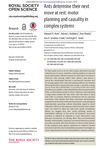Ants determine their next move at rest
| dc.contributor.author | R. Hunt, Edmund | en_US |
| dc.contributor.author | J. Baddeley, Roland | en_US |
| dc.contributor.author | Worley, Alan | en_US |
| dc.date.accessioned | 2016-10-11T05:37:21Z | |
| dc.date.available | 2016-10-11T05:37:21Z | |
| dc.date.issued | 2016 | en_US |
| dc.identifier.other | HPU4160679 | en_US |
| dc.identifier.uri | https://lib.hpu.edu.vn/handle/123456789/23570 | |
| dc.description.abstract | To find useful work to do for their colony, individual eusocial animals have to move, somehow staying attentive to relevant social information. Recent research on individualTemnothorax albipennis ants moving inside their colony’s nest found a power-law relationship between a movement’s duration and its average speed, and a universal speed profile for movements showing that they mostly fluctuate around a constant average speed. From this predictability it was inferred that movement durations are somehow determined before the movement itself. Here, we find similar results in loneT. albipennisants exploring a large arena outside the nest, both when the arena is clean and when it contains chemical information left by previous nest-mates. | en_US |
| dc.format.extent | 19 p. | en_US |
| dc.format.mimetype | application/pdf | |
| dc.language.iso | en | en_US |
| dc.subject | Biology | en_US |
| dc.subject | Biocomplexity | en_US |
| dc.subject | Behaviour | en_US |
| dc.subject | Cognition | en_US |
| dc.subject | Movement | en_US |
| dc.subject | Motor planning | en_US |
| dc.subject | Self-similarity | en_US |
| dc.subject | Division of labour | en_US |
| dc.subject | Intermittent top-down causality | en_US |
| dc.subject | Complex social systems | en_US |
| dc.title | Ants determine their next move at rest | en_US |
| dc.type | Article | en_US |
| dc.size | 0.99MB | en_US |
| dc.department | Education | en_US |
Files in this item
This item appears in the following Collection(s)
-
Education [806]

